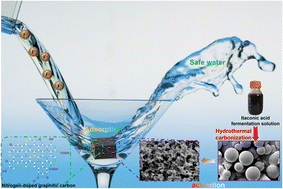High-efficiency N-doped activated carbon-based defluoridation adsorbent prepared from itaconic acid fermentation waste liquid†
Abstract
Excessive amounts of fluoride in water cause irreversible harm to people and seriously threaten human health. Therefore, fluoride ion in water should be deeply removed. The waste liquor of itaconic acid fermentation contains many organic acids, residual sugars, proteins, and other impurities, which are difficult to remove. Thus, in this study, the itaconic acid fermentation waste liquid was successfully mixed with urea to prepare N-doped porous carbon (PC-N). The prepared PC-N was applied for the removal of fluoride in water. The specific surface area of PC-N is as high as 1803 m2 g−1, and the SEM results show an abundant pore structure. The FTIR results showed that the adsorbent surface had an abundant functional group structure. The removal rate of F− by PC-N was 91% when pH = 6. After 6 cycles of recycling, PC-N performance remains stable at about 73% of that of the fresh adsorbent. Moreover, Freundlich and PSO can better fit the adsorption data, indicating that F− on PC-N adsorption results from the joint action of physical and chemical adsorption. After calculating the adsorption thermodynamics, ΔH and ΔS are −14.5529 kJ mol−1 and 13.6507 J (mol K)−1, and ΔG is negative, indicating that the adsorption process is exothermic and spontaneous. The outcome results of this work have achieved the goal of “treating waste with waste” and realized the dual protection of the environment.



 Please wait while we load your content...
Please wait while we load your content...